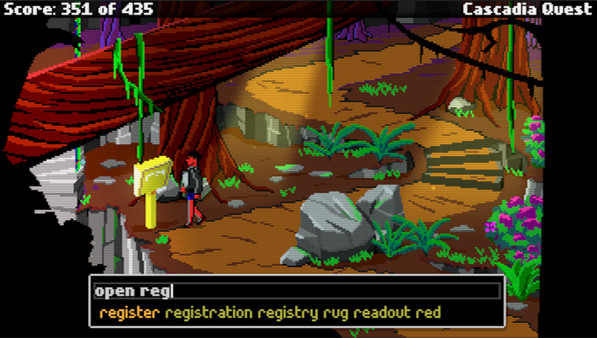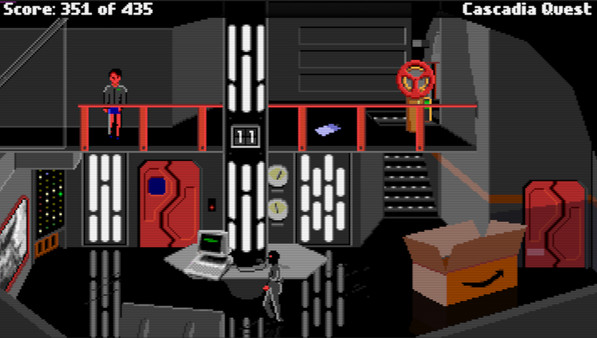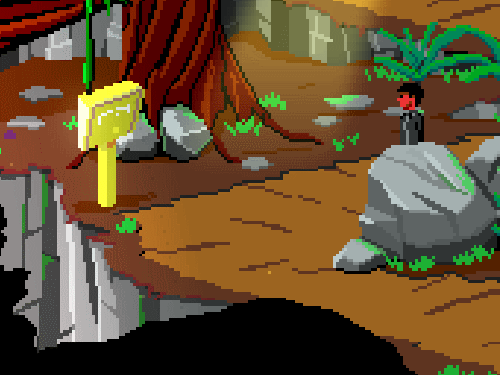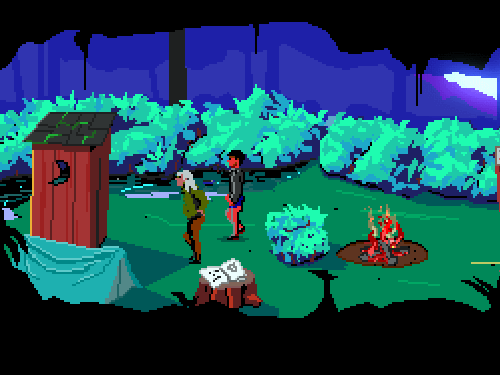V_K
Arcane
The trailer looks like Sam's shit.
The trailer looks like Sam's shit.
I'd rate that post with a "monocled shit" button but as a non-paid member I don't have it.My headcanon is that sam takes nicer shits than this.


One thing you forgot to mention (but it kinda reinforces your main points): the Magic Map. Once you have it, and go down the mountain path once, you never have take it down again, only back up (you can use the map to teleport from the house to anywhere else you've been, including the base of the path, except for the house itself). Having the map work like this accomplishes two things. First, it makes going back out the second (or third) time less arduous, which is a very subtle way of showing that Gwydion is gaining a sense of confidence (you still have to go back up, but that ties with what you said about having to hurry back while the clock is ticking, which adds tension. And you don't have to hurry, and can take your time on the path up, if you plan ahead and leave ample time to go back, which is good design). Second, and related to this, it shrinks that gap you mentioned between Gwydion and Manannan, which is the entire point of the first part of the game and why Gwydion starts learning to use magic. True, Manannan can still teleport back and forth at will, and you can't, but now you also have quick means of transport out of the house to other places. And the next step is eliminating the power gap entirely - and that's exactly the goal of this part of the game.The player soon realizes that to win the game, she needs to sneak out of the house, gather tools in the land below, and then get back before Manannan notices Gwydion's absence. But every jaunt out of the house, and every hurry back home, has the cruel mountain path en route. The player's fear in facing that path serves as an emotional approximation of Gwydion's fear. "God, I really have to try to sneak out again?"
Additionally, the path plays two thematic roles. Such perilous roads are a routine part of fairy tales and folklore — the one we all know is from Red Riding Hood, but they're all over the place, actually — and so its inclusion in the fairy-tale-based King's Quest franchise is appropriate for that reason alone. But the road also serves the emphasize the power differential between Manannan (who can teleport to and from the house at his pleasure) and Gwydion (for whom such foot travel poses deadly peril), as well as providing a sharp geographic boundary between the fairly idyllic land of Llewdor (notwithstanding its own monsters and dangers) and the miserable home of Manannan.







My personal goal has always been to be a Triple-A player. I can’t honestly say that I have ever achieved that goal. If I’m awake I’m usually either working or thinking about working. If I’m reading it is usually some sort of self-help book.
When most people think about Sierra’s past they remember us as an “Adventure Game Company.”
I’m not opposed to that, but it’s not at all how I remember the company.
To me, Sierra was a marketing company. Lots of people can design products, code products, advertise products, and sell products. But, what really lifted Sierra above the pack, and the reason you are reading this book twenty-five or more years past when the Sierra I knew died, was our marketing.
I knew that I was young and uneducated, and in over my head. It really was
“on-the-job training.” To compensate, I read entire shelves of books at
bookstores that were filled with self-help books, much to the frustration of
those who reported to me. There are a lot of books that talk about how to
run a business. I especially liked the ones written by corporate CEOs who
had run rapidly growing businesses. The thing that my team didn’t like was
that I tended to manage according to the book I read most recently. I was
often accused of giving them whiplash as I’d argue one way this week and
another the following week.
Of all the games Sierra ever produced, Leisure Suit Larry was always my favorite.
I took a special interest in the Leisure Suit Larry series, and even did some programming on the series over the years.
Unlike movies, there was no rating system for games. I’ve always thought children should be protected from adult content. One day I came up with the idea of putting a quiz at the start of the games. The idea was that the game could ask questions drawn from the headlines and if the player couldn’t answer the questions the game would refuse to load. The trivia game itself became something fun to do, but we goofed and forgot that these games would have a long life. I remember that one of the questions asked the name of Senator Gary Hart’s boat (a major headline at the time, as he overnighted on his boat, Monkey Business, with his alleged girlfriend). At the time, everyone over 18 years of age knew the answer. Today, you’d need to be over 65 and have good memory.
Even before the phrase #metoo became a household word, there was sensitivity around Leisure Suit Larry. My guess is that if you agonize over every line of dialog in a Leisure Suit Larry game you can find some line, probably several, that can be interpreted as sexist. The same is probably true with every risqué comedy movie or TV series ever made. My thinking was always that Larry was funny, and that both Al Lowe and I had incredibly strong wives. Sierra certainly had no lack of women in powerful positions, and the whole joke in the games was that Larry was a lovable loser who could only dream of catching a sexy member of the opposite sex. The joke was on Larry, not the women. I’d also point out that I watched and spoke with many women who played the game and none seemed offended. And, ultimately, Larry could easily be compared to movies like Ferris Bueller’s Day Off. If I were making films would I have made that film? Would you? Of course! Audiences loved it, and no one crammed it down their throats.
My philosophy of game design was that customers will forgive about
anything if they believe the person who created the game took it seriously.
You can have misspellings. The game can crash. But, when it comes to
nailing the subject matter, you can’t screw it up. I used to describe playing
a game as being like “having lunch with the designer.”
It may sound funny that I am talking about game design philosophy in
a chapter about marketing strategy, but … the #1 marketing strategy at
Sierra was to find the right designers, and empower them to produce their
games, without muddying their vision.
That last bit of that last paragraph is more important than the three words
imply, “… muddying their vision ….” This was a battle I fought every day
and was the piece of the puzzle over which I was the most protective. My
goal was to empower people who were passionate about a product to bring
it to market with as little interference as possible.
If we were producing a cribbage game, I didn’t want some artist figuring
out what the cribbage board looked like. I wanted my designer, who had
to live and breathe cribbage, putting their personal mark on the product.
Every detail, every piece of art, every game challenge, every piece of music,
had to flow from the designer. If the music they picked was dumb and off
key, it was their right and their design. This was a key reason that I pushed
our having a tools group. I wanted non-technical people to be able to build
a product. It was important to remove the technological wall between
content creators and content consumers.
I wanted a designer who was passionate about something to be able to
make their vision a reality with the least interference possible. I was into
empowering an individual designer, not into producing a product that was
a team effort. I constantly argued that if you were to take the two greatest
book authors in the world and have them collaborate on a book, the result
would not be as strong as their producing two independent books. Teams
muddle products.
![The Year of Incline [2014] Codex 2014](/forums/smiles/campaign_tags/campaign_incline2014.png)


Cascadia Quest is a reboot of the classic adventure games from the mid eighties. You'll take on the role of an eager but incompetent junior ranger in the lush forests surrounding Foreboding Spire. You'll be sent on a wild adventure into deep forest, up snowy mountains, into mysterious caverns, all the while trying to uncover a mysterious plot to sabotage the wilderness. The game is infused with lore from the Pacific Northwest region of the USA.
Before point-and-click games came along, adventure game characters were controlled by typing. Frustrating? By today's standards, yes it was! Cascadia Quest brings this back this freedom, but with a modern contextual parser including futuristic features like autosuggest.


If you ever miss your time spent as a space-faring janitor, a teenager imprisoned by a terrifying wizard, or a young journalist investigating a murder in a mansion, then Cascadia Quest is ready to welcome you back.
Key Features
- Location-aware text parser with both auto-suggest and auto-correct - fat finger your way to puzzle glory. Using a parser was never more effortless.
- Autosaves - no need to save every few minutes before you try something risky.
- Deaths (but hey, autosaves)!
- No dead ends! Puzzle your way around with impunity!
- Bright EGA-ish graphics that evoke that classic feel while looking modern.
- CRT emulation mode that gives those pixels an ever-so-slightly fuzzy look.
- A way to turn off modern conveniences if you want that true retro challenge! Control your dither level!
Some other Demos in the Point&Click section that can still be played till tomorrow:
Another Myst Clone but it seems there is no environmental storytelling similar to Myst.
Ugh. Sounds like "a more and more tiresome pixel hunt".Another Myst Clone but it seems there is no environmental storytelling similar to Myst.
Zof is a different kind of puzzle game. The solutions are always simple, just more and more carefully hidden.

Ugh. Sounds like "a more and more tiresome pixel hunt".
Noir Adventure CHICKEN POLICE has a demo out on Steam.
You can complete the demo in an about an hour. Game's fun enough.







